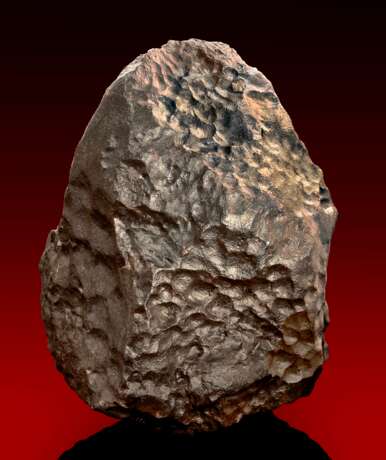ID 389970
Lot 27 | NWA 13260 — A MASSIVE STONE METEORITE WITH NATURAL DESERT VARNISH
Valeur estimée
$ 25 000 – 35 000
Covered in a warm-hued natural desert varnish, three sides of this massive meteorite display regmaglypts (the aerodynamic thumbprinting that occurs as the rock’s melted surface interacts with Earth’s increasingly dense atmosphere). A small core sample was taken from the reverse to facilitate analysis and classification, which provides a window to the internal matrix. Surprisingly dense, this meteorite contains countless metallic flakes suspended throughout its matrix — a signature feature of an H6 meteorite. 99% of all stone meteorites are less massive than this imposing, compelling specimen.
239 x 311 x 218mm (9.5 x 12.25 x 8.5 in.)
27.15kg (59.75 lbs)
The only specimen of NWA 13260 known to exist — and the quintessence of a massive stone meteorite. To enable scientists to refer to the attributes of a given meteorite, there must be a nomenclature system, and so a committee of scientists on the Nomenclature Committee of the Meteoritical Society name meteorites after the location to which they’ve been “delivered,” (e.g., a city, village, mountain, river, county, etc.). In a desert, where there are few distinguishing geological landmarks, meteorites are named after delimited areas and are assigned sequential numbers. This meteorite was found in what was named the North West African area of the Sahara Desert in 2018. As it is the 13,260th meteorite to be catalogued following its recovery in this area, its official name is NWA 13260. The H6 classification indicates the meteorite has large amounts of free iron and experienced moderate metamorphism on its parent asteroid before being launched into interplanetary space by an energetic asteroidal collision. The exterior surface of this meteorite is accented with regmaglypts, an artifact that results from frictional heating during its descent through Earth’s atmosphere. Most meteorites this size are barely warm to the touch when they reach the ground. This is due to the freezing-cold interior of the rock in space (-457º F) and the very slow diffusion of heat from the rock’s surface during its brief fiery descent to Earth.
Christie's would like to thank Dr. Alan E. Rubin at the Institute of Geophysics and Planetary Physics, University of California, Los Angeles for his assistance in preparing this catalogue.
| Adresse de l'enchère |
CHRISTIE'S 8 King Street, St. James's SW1Y 6QT London Royaume-Uni | |
|---|---|---|
| Aperçu |
| |
| Téléphone | +44 (0)20 7839 9060 | |
| Commission | see on Website | |
| Conditions d'utilisation | Conditions d'utilisation |



